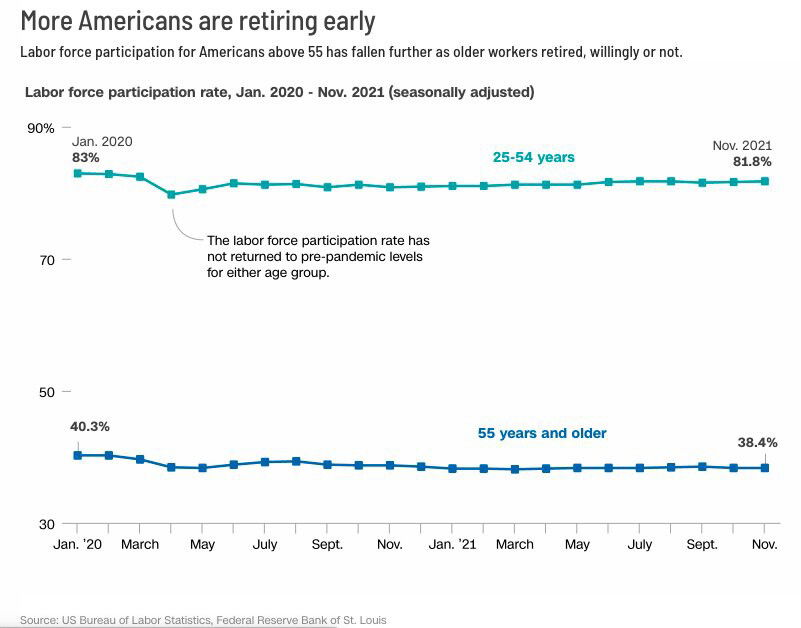Three key numbers that explain America’s labor shortage

By Anneken Tappe and Allison Morrow, CNN Business
Twenty-one months into the pandemic, America is no longer struggling with an astronomically high unemployment rate. Instead, it’s big problem remains a shortage of workers.
That makes it hard for businesses to keep up with rampant demand. Economists worry how long it will take for people on the sidelines to come back into the workforce.
For much of the pandemic, economists agreed that child care challenges and worries about the virus were keeping people from returning to the labor market.
But recently, it has become clear that there is another dynamic at work here: early retirement.
Retirement is changing the workforce
The percentage of Americans who are in the job market, either as workers or as active job seekers, is measured by the labor force participation rate. And that rate is nowhere near it’s pre-pandemic level. As of November, the measure stood at 61.8%, having recovered about half of what was lost at height of the pandemic compared with the Feburary 2020 rate of 63.3%.
That difference might not sound like a lot, but it accounts for millions of people. The participation rate for men has also recovered more than that for women, likely because more women dropped out of the workforce last year for child care reasons.
But the chart above doesn’t show the workforce recovery for different age groups.
For example, the group considered “prime age” age workers — aged 25-54 — are on a much steeper recovery track. Since May this year, their participation rate has been tracking consistently higher. It stood at 82.1% in November, compared with 83.1% pre-pandemic.
Meanwhile, the participation rate tracking workers above the age of 55 has remained drastically low: It stood at 38.4% in November compared with 40.3% pre-pandemic in February 2020.
Perhaps more importantly, participation for older workers fell to its pandemic-era low in May 2021, when it dropped to 38.2%, not far off the current rate. Overall, participation for this group has remained pretty much flat during 2021.
The lack of recovery in participation of older workers leads to the conclusion that early retirement — whether forced or voluntary — is a big part of the participation rate puzzle.
Forced into early retirement
While early retirement may sound like a dream to some, it’s not necessarily a happy story for everyone.
To be sure, some older workers, classified as 55 years of age and above, found themselves benefiting from the strong stock market of the past years, or rising home prices, so early retirement could be a conscious decision.
But others found themselves forced out of the workforce. Furloughed or laid off, these workers left their previous jobs and found themselves not only in a higher risk group for Covid but also unemployed.
And getting back to work at an older age can prove tricky.
Linda Plaza from California found herself terminated from her job as a cloud consultant in October 2020 when her employer reorganized.
“I was planning to retire at 65,” she told CNN Business.
Now 64, she says it’s near impossible to find another job like her old one: “And if they were going to hire anyone, they will hire someone younger with more education.”
And other jobs around her are in retail or food services, which bears infection risk.
For Linda, having to retire early turned her personal finances upside down, not least because her husband already retired and she has to pay for her health insurance out of pocket now. The couple has also fallen behind on their mortgage.
“I want people to know that things are not okay,” Linda told CNN Business.
The advent of the highly-infectious Omicron variant is putting health concerns for workers front and center again. It could make it even harder for older workers to come back into the workforce even if they need to.
The-CNN-Wire
™ & © 2021 Cable News Network, Inc., a WarnerMedia Company. All rights reserved.